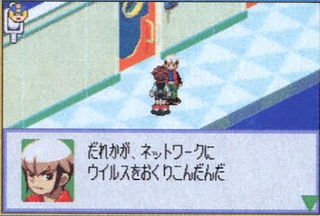User:BigBakudan/''Battle Network 1'' Prerelease Replacement
This is a sub-page of User:BigBakudan.
| This article is a work in progress. ...Well, all the articles here are, in a way. But this one moreso, and the article may contain incomplete information and editor's notes. |
| To do: Concept art and the game's design document. Also, check if this game was revealed at or around the time of SpaceWorld 2000. |
Sometime around late 1999, the people at Capcom Production Studio 2 created an idea for a horror game that would target the (then upcoming) Game Boy Advance. This idea would ultimately fall through for a number of reasons however, so the devs improvised the idea for Battle Network Rockman EXE/Mega Man Battle Network (which initially didn't use the Mega Man IP) as a backup plan.
The game went through many changes throughout its year long development cycle (January 31, 2000--January 20, 2001), most notably the battle system which underwent radical changes in the months leading up to release.
Contents
Subpages
| January 31, 2000 Design Document The very first draft of Mega Man Battle Network. The game's battle system hadn't even been created yet and several characters use their "classic" designs as placeholders. |
| Concept Art Early MegaMan.EXE and PET designs galore! |
Early Development
| To do: Add more info. |
Before Battle Network
In late 1999, Capcom received devkits for the then-upcoming Game Boy Advance. This prompted the devs at Capcom Production Studio 2 to begin drafting potential game ideas. Their first idea was a horror game that would rely on the player's heartbeat by using a wearable add on. Lead programmer Koetsu Matsuda would visit a haunted house at Expoland to get ideas for the game. This game wouldn't make it far into development however; as the add on proved to be too difficult to work with.
A Mega Man RPG
In the late '90s, the massive success of Pokémon and Yu-Gi-Oh! led to a surge in popularity for card games. Capcom's executives wanted to capitalize on this popularity, so they tasked Production Studio 2 with the concept of a virtual card game. The developers wanted to make a card game that only Capcom could make, so they chose Mega Man (since he was a Capcom icon and popular with kids) as the main protagonist. They also replaced the cards with "data" (since Mega is a robot), which would quickly evolve into "battle chips". Lastly, they decided to base the series around a "network society", as the internet was still new at the time.
The PET and Network Society
One of the core parts of the Battle Network series is the PErsonal Terminal (PET). The PET was created to give kids the feeling of owning a cell phone as, at the time, kids did not typically have phones. Additionally, the series' network society was designed to be a near future version of current society so it could resonate better with kids.
| To do: Add more info, like the reason that EXE has a face mask. |
The "Test Build"
| To do: Find out when this build was first showcased. Also, there's a lot more images of this build out there. |
The earliest publicly known build of Mega Man Battle Network has been dubbed a "test build" by the developers; according to Masahiro Yasuma, the player would've started at school and talked to every person before they fought WoodMan, after which the game would end. Screenshots from this build were shown in the November 2000 issue of Dengeki Nintendo 64 magazine, but the build itself is from a much earlier point in development (likely around mid-2000).

A virus battle; the HUD was completely different, battle chips at the edge of the screen instead of on-top of the player/enemies. The bar at the top of the screen was part of this build's "tug of war" system, where the player or enemy would lose if their bar was depleted, only to be scrapped due to being too cumbersome to work with.
The panels and the background with Congo text are not present in the final build.

Apparently Chaud was going to be Lan's classmate at this point; his portrait here is slightly different, as is the PET icon, which closer resembles the early laptop-styled concept art. The text here, translated, reads "Someone is going to have to enter the network. They sent a virus in."
